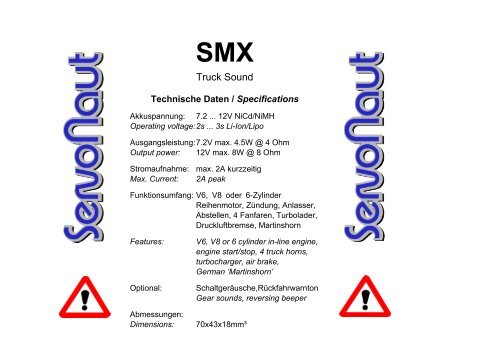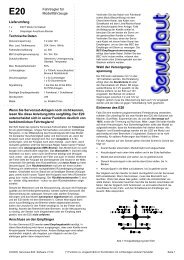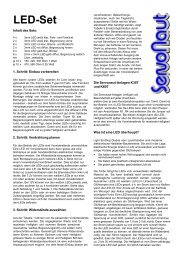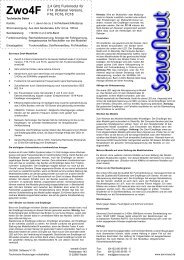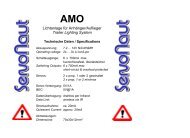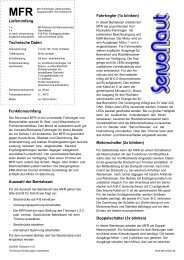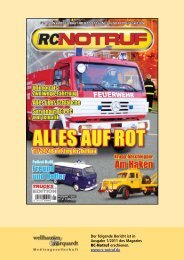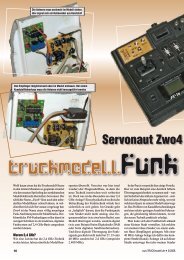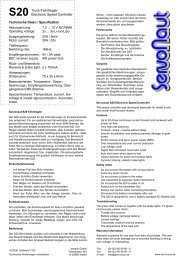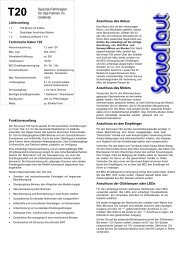SMX - Servonaut
SMX - Servonaut
SMX - Servonaut
Sie wollen auch ein ePaper? Erhöhen Sie die Reichweite Ihrer Titel.
YUMPU macht aus Druck-PDFs automatisch weboptimierte ePaper, die Google liebt.
<strong>SMX</strong><br />
Truck Sound<br />
Technische Daten / Specifications<br />
Akkuspannung: 7.2 ... 12V NiCd/NiMH<br />
Operating voltage: 2s ... 3s Li-Ion/Lipo<br />
Ausgangsleistung: 7.2V max. 4.5W @ 4 Ohm<br />
Output power: 12V max. 8W @ 8 Ohm<br />
Stromaufnahme: max. 2A kurzzeitig<br />
Max. Current: 2A peak<br />
Funktionsumfang: V6, V8 oder 6-Zylinder<br />
Reihenmotor, Zündung, Anlasser,<br />
Abstellen, 4 Fanfaren, Turbolader,<br />
Druckluftbremse, Martinshorn<br />
Features:<br />
Optional:<br />
Abmessungen:<br />
Dimensions:<br />
V6, V8 or 6 cylinder in-line engine,<br />
engine start/stop, 4 truck horns,<br />
turbocharger, air brake,<br />
German ‘Martinshorn’<br />
Schaltgeräusche,Rückfahrwarnton<br />
Gear sounds, reversing beeper<br />
70x43x18mm³
<strong>SMX</strong> Truck-Soundmodul<br />
Das <strong>SMX</strong> ist mit Originalaufnahmen von einem<br />
V6, V8 und 6-Zylinder Truck-Reihenmotor programmiert<br />
und gibt diese mit hoher Qualität fahrsituationsabhängig<br />
wieder.<br />
Eigenschaften<br />
· 3 originale Motor-Sound-Aufnahmen<br />
· Dynamische, fahrsituationsabhängige Geräuschkulisse<br />
· 2 Fanfaren in je 2 Varianten<br />
· Realistisches Turbolader-Pfeifen<br />
· Bremsgeräusche, Martinshorn<br />
· Rückfahrwarnton und Schaltgeräusche (abhängig<br />
vom Fahrtregler)<br />
· Akustische Simulation eines Nebenabtriebs<br />
(Hydraulikpumpe) möglich<br />
· Kein Zusatz-Akku nötig, kann direkt aus<br />
Fahrakku versorgt werden<br />
· Anlasser/Fanfare wahlweise über Empfänger<br />
oder Multiswitch ansteuerbar<br />
· Erweiterbar mit dem programmierbaren Geräuschmodul<br />
SM+ von ServoNaut<br />
<strong>SMX</strong> Sound Module for Trucks<br />
The <strong>SMX</strong> is programmed with original sounds of<br />
a V6, V8 and a 6-cylinder in-line truck engine. It<br />
will replay these recordings with high quality and<br />
realistically adapted to the state of driving.<br />
Features<br />
3 original motor sound recordings<br />
Dynamically changing sound replay<br />
2 types of horns, each of them in 2 variants<br />
Realistic turbocharger effect<br />
Compressed-air break, emergency siren<br />
(‘Martinshorn’ as used in Germany)<br />
Reversing beeper and gearbox sounds (depending<br />
on the speed controller)<br />
Acoustic simulation of auxiliary drive (e. g.<br />
hydraulic pump) possible<br />
No extra battery necessary, can directly be<br />
powered from main battery<br />
Ignition/horn activated via receiver channel<br />
or multiswitch output<br />
Expandable with the programmable sound<br />
add-on module SM+ from ServoNaut
<strong>SMX</strong> mit Standard-Fahrtregler/MFR<br />
Das Bild rechts zeigt den Anschluss des <strong>SMX</strong> an<br />
einen Standard-Fahrtregler (gilt auch für den MFR).<br />
Das <strong>SMX</strong> wird über das rote (+) und schwarze (-)<br />
Kabel mit dem Fahr-Akku verbunden. Der Lautsprecher<br />
muss an die gelben Kabel angelötet werden.<br />
Das im Bild als FR/ESC gekennzeichnete<br />
Kabel (mit blauem Stecker-Gehäuse) wird in den<br />
Empfänger-Steckplatz gesteckt, wo normalerweise<br />
der Fahrtregler angeschlossen ist (hier: Kanal 3).<br />
Das Servokabel des Fahrtreglers kommt an den<br />
‚Regler/ESC’-Anschluss des <strong>SMX</strong>. Über einen zusätzlichen<br />
Empfangskanal werden Anlasser und<br />
Fanfare (F1+F2) aktiviert (hier: Kanal 8). Anschlüsse<br />
F3 und F4 sind Schalteingänge, die von einem Multiswitch<br />
(z. B. <strong>Servonaut</strong> MM4) geschaltet werden<br />
können. F3 schaltet normalerweise das Martinshorn,<br />
F4 das Nebenantriebs-Geräusch. F4 kann auch direkt<br />
mit einem Stellmotor verbunden werden. Die<br />
Schaltfunktionen F1+F2 können mit den Funktionen<br />
F3+F4 getauscht werden. (siehe Kapitel Schaltfunktionen).<br />
Die SM+ Erweiterung wird wie abgebildet<br />
angeschlossen (kurzes Servokabel ans <strong>SMX</strong>,<br />
langes Servokabel an freien Empfänger-Kanal, hier:<br />
Kanal 9).<br />
<strong>SMX</strong> with Standard ESC or MFR<br />
The picture to the right shows the interconnection<br />
of the <strong>SMX</strong> to a standard speed controller<br />
(also true for <strong>Servonaut</strong> MFR).<br />
Connect the <strong>SMX</strong> to the battery via the red (+)<br />
and the black (-) cable. The yellow cables have<br />
to be soldered to the loudspeaker. Plug ‘FR/ESC’<br />
(blue housing) into receiver position which normally<br />
holds the throttle channel (here: channel<br />
3). Throttle cable goes into ‘Regler/ESC’ of <strong>SMX</strong><br />
instead . Starter and horn (F1+F2) are controlled<br />
via another receiver channel (here: channel 8).<br />
Connections F3 and F4 are normally used in<br />
conjunction with a multiswitch (e. g. <strong>Servonaut</strong><br />
MM4). F3 switches the ‘Martinshorn’ (a special<br />
sort of alarm siren used in Germany). F4 is used<br />
to simulate an auxiliary drive. You can connect it<br />
directly to the drive motor as well. Functions<br />
F1+F2 and F3+F4 can be interchanged (see<br />
chapter Switching Functions). The SM+ add on<br />
is installed as shown (short cable plugged into<br />
<strong>SMX</strong>, long cable plugged into free receiver channel,<br />
here for example: channel 9).
<strong>SMX</strong> mit Standard-Fahrtregler<br />
<strong>SMX</strong> with Standard ESC<br />
Fahrtregler<br />
SM+<br />
(Option)<br />
Empfänger<br />
ESC<br />
Lautstärke<br />
Volume<br />
Receiver<br />
FR/ESC<br />
F1+F2<br />
<strong>SMX</strong><br />
Akku<br />
Battery<br />
F3<br />
F4
<strong>SMX</strong> mit <strong>Servonaut</strong>-Regler<br />
Auf der Abbildung rechts ist stellvertretend der S20<br />
abgebildet. Die folgende Beschreibung gilt aber<br />
ebenso für die <strong>Servonaut</strong> Regler-Familien E, K, M<br />
und T.<br />
Das <strong>SMX</strong> wird über das rote (+) und schwarze (-)<br />
Kabel mit dem Akku verbunden. Der Lautsprecher<br />
muss an die gelben Kabel angelötet werden. Das<br />
im Bild als FR/ESC gekennzeichnete Kabel (mit<br />
blauem Stecker-Gehäuse) wird in den passenden<br />
Anschluss des <strong>Servonaut</strong>-Fahrtreglers gesteckt<br />
(Anschluss ‚Sound’). Über einen zusätzlichen Empfangskanal<br />
werden Anlasser und Fanfare (F1+F2)<br />
aktiviert (hier: Kanal 8). Anschlüsse F3 und F4 sind<br />
Schalteingänge, die von einem Multiswitch(z. B.<br />
<strong>Servonaut</strong> MM4) geschaltet werden können. F3<br />
schaltet normalerweise das Martinshorn, F4 das<br />
Nebenantriebs-Geräusch. F4 kann auch direkt mit<br />
einem Stellmotor verbunden werden. Die Schaltfunktionen<br />
F1+F2 können mit den Funktionen<br />
F3+F4 getauscht werden. (siehe Kapitel Schaltfunktionen).<br />
Die SM+ Erweiterung wird wie abgebildet<br />
angeschlossen (kurzes Servokabel ans <strong>SMX</strong>,<br />
langes Servokabel an freien Empfänger-Kanal,<br />
hier: Kanal 9).<br />
<strong>SMX</strong> with <strong>Servonaut</strong> ESC<br />
The picture to the right shows the S20. The following<br />
description however is also true for <strong>Servonaut</strong><br />
controller families E, K, M and T.<br />
Connect the <strong>SMX</strong> to the battery via the red (+)<br />
and the black (-) cable. The yellow cables have<br />
to be soldered to the loudspeaker. Plug ‘FR/ESC’<br />
(blue housing) into matching port of the <strong>Servonaut</strong><br />
speed controller (‘Sound’ connector). Starter<br />
and horn (F1+F2) are controlled via another receiver<br />
channel (here: channel 8). Cables F3 and<br />
F4 are normally used in conjunction with a multiswitch<br />
(e. g. <strong>Servonaut</strong> MM4). F3 switches the<br />
‘Martinshorn’ (a special sort of alarm siren used<br />
in Germany). F4 is used to simulate an auxiliary<br />
drive. You can connect F4 directly to the drive<br />
motor as well. Functions F1+F2 and F3+F4 can<br />
be interchanged (see chapter Switching Functions).<br />
The SM+ add on is installed as shown<br />
(short cable plugged into <strong>SMX</strong>, long cable<br />
plugged into free receiver channel, here: receiver<br />
channel 9).
<strong>SMX</strong> mit <strong>Servonaut</strong>-Regler<br />
<strong>SMX</strong> with <strong>Servonaut</strong> ESC<br />
Empfänger<br />
S20<br />
SM+<br />
(Option)<br />
Receiver<br />
F1+F2<br />
FR/ESC<br />
<strong>SMX</strong><br />
Volume<br />
Lautstärke<br />
Akku<br />
Battery<br />
F3<br />
F4
Schaltfunktionen<br />
Die Schaltfunktionen F1 und F2 können mit den Funktionen<br />
F3 und F4 getauscht werden. Jeweils zwei<br />
Funktionen werden über einen Empfängerkanal geschaltet<br />
und zwei Funktionen über einen beliebigen<br />
Multiswitch. Die Auswahl erfolgt mit der oberen Steckbrücke:<br />
· Obere Steckbrücke auf B-A (Standard):<br />
Anlasser (F1) und Fanfare (F2) werden über einen<br />
extra Empfängerkanal betätigt. Am Sender kann dazu<br />
wahlweise ein freier Kanal mit Kreuzknüppel oder mit<br />
Schalter/Taster verwendet werden (vorzugsweise Taster<br />
mit Ruhe-Mittelstellung).<br />
Für F3 und F4 wird ein Multiswitch-Systeme mit Memory-<br />
oder Tast-Funktion benötigt. Der Schalteingang<br />
F3 steuert das Martinshorn, der Schalteingang F4 erhöht<br />
die Leerlaufdrehzahl zur Simulation eines Nebenantriebs.<br />
Der Eingang F4 kann auch direkt mit dem<br />
Antriebsmotor einer Hydraulikpumpe oder eines Stellantriebs<br />
verbunden werden, sofern dieser Motor nur<br />
an/aus betrieben wird. (Funktioniert nur in einer Drehrichtung)<br />
· Obere Steckbrücke auf C-B:<br />
Anlasser und Fanfare werden über die Schalteingänge<br />
F3 und F4 betätigt. Benötigt wird ein Multiswitch-System<br />
mit Tastfunktion für die Fanfare und Memory-<br />
Funktion für den Anlasser. Der Schaltkanal F1+F2 betätigt<br />
das Martinshorn und die Simulation eines Nebenantriebs,<br />
kann aber auch ungenutzt bleiben.<br />
Switching Functions<br />
The switching functions F1 and F2 can be<br />
swapped with functions F3 and F4. Two functions<br />
are controlled by a receiver channel and two functions<br />
are controlled by a multiswitch.<br />
Setup is as follows:<br />
Upper jumper in position B-A (standard setup):<br />
Starter (F1) and Horn (F2) are activated via receiver<br />
channel. Either use a stick channel or a switch<br />
with three positions (momentary function would be<br />
best). Switching input F3 controls the ‘Martinshorn’.<br />
Input F4 increases the pitch of the idling<br />
sound, thus simulating an active auxiliary drive.<br />
You can use multiswitch systems with memory or<br />
momentary function. F4 can also be directly connected<br />
to a motor of a hydraulic pump or actuator<br />
drive motor, as long as this motor is switched on<br />
and off only (works in one direction only).<br />
Upper jumper in position C-B:<br />
Starter and Horn are controlled by switching inputs<br />
F3 und F4. You need a multiswitch system with a<br />
momentary function for the horn and a memory<br />
function for the starter. Receiver channel activates<br />
the ‘Martinshorn’ (F1) and auxiliary drive simulation<br />
(F2). If you don’t need any of these options<br />
you can leave them unconnected as well.
Jumper-Einstellungen<br />
Anlasser/Horn: F1 + F2 Motor-Sound:<br />
Reihen-6<br />
1<br />
B A<br />
E D<br />
Jumper Settings<br />
Starter/Horn: F1 + F2<br />
Motor sound: 6 in-line<br />
Anlasser/Horn: F1 + F2 Motor-Sound:<br />
V6<br />
2 B A<br />
Starter/Horn:<br />
Motor sound:<br />
F1 + F2<br />
V6<br />
Anlasser/Horn: F1 + F2 Motor-Sound:<br />
V8<br />
3<br />
B A<br />
F E<br />
Starter/Horn:<br />
Motor sound:<br />
F1 + F2<br />
V8<br />
Anlasser/Horn: F3 + F4 Motor-Sound:<br />
Reihen-6<br />
4<br />
C B<br />
E D<br />
Starter/Horn:<br />
Motor sound:<br />
F3 + F4<br />
6 in-line<br />
Anlasser/Horn: F3 + F4 Motor-Sound:<br />
V6<br />
5<br />
C B<br />
Starter/Horn:<br />
Motor sound:<br />
F3 + F4<br />
V6<br />
Anlasser/Horn: F3 + F4 Motor-Sound:<br />
V8<br />
6<br />
C B<br />
F E<br />
Starter/Horn:<br />
Motor sound:<br />
F3 + F4<br />
V8<br />
Setup - siehe ‚Setup-Menü’<br />
(Motor-Jumper beliebig)<br />
7<br />
Setup - see ‘Setup Menu’<br />
(Motor jumper arbitrary)
Setup-Menü<br />
Weitere Einstellmöglichkeiten sind über ein Menü erreichbar.<br />
Für die Bedienung des Menüs muss der<br />
Schaltkanal F1+F2 verwendet werden. Verbinden Sie<br />
den Anschluss für diese Einstellungen falls erforderlich<br />
vorübergehend mit einem Kanal der Kreuzknüppel.<br />
· <strong>SMX</strong> vom Akku trennen<br />
· Steckbrücke an C-B-A entfernen<br />
· <strong>SMX</strong> einschalten, Bremsgeräusch ertönt<br />
Mit dem Knüppel in eine Richtung werden jeweils vier<br />
Stufen der Reihe nach ausgewählt. Eine Betätigung<br />
des Knüppels in die andere Richtung bestätigt die Einstellung<br />
und der nächste Menüpunkt wird angewählt.<br />
Fünf Menüpunkte werden nacheinander angeboten:<br />
· Lautst. der Druckluftgeräusche, leiseste Stufe=aus<br />
· Lautst. des Rückfahrwarntons, leiseste Stufe=aus<br />
· Schaltgeräusch, zwei Varianten in zwei Lautstärken<br />
· Lautstärke des Turboladers, leiseste Stufe=aus<br />
· Fanfare, vier Varianten<br />
Mit der Bestätigung des letzten Menüpunkts ertönt kurz<br />
das Martinshorn und die Einstellungen werden gespeichert.<br />
Zum Abschluss das <strong>SMX</strong> abschalten und die<br />
Steckbrücke wieder einsetzen. Wird das <strong>SMX</strong> vorher<br />
abgeschaltet, bleiben alle Einstellungen dagegen unverändert.<br />
Setup Menu<br />
There are even more options which are changed via<br />
a built-in setup menu. In order to control this menu<br />
you need switching function F1+F2. It would be best<br />
to temporarily plug this connection into a receiver<br />
channel with stick control by the radio.<br />
Switch off <strong>SMX</strong><br />
Remove jumper C-B-A<br />
Switch on <strong>SMX</strong>, air break will sound<br />
Moving stick in one direction cycles through four setup<br />
levels. Moving stick in opposite direction advances<br />
to next menu item.<br />
Following five successive items exist:<br />
Volume of air break, lowest level=off<br />
Volume of reversing beeper, lowest level=off<br />
Gear sound, two variants with two volume levels<br />
Volume of turbocharger, lowest level=off<br />
Horn sound, four variants<br />
After leaving the last menu item you will hear the<br />
‘Martinshorn’ sound and changes will be saved. Finally,<br />
switch off <strong>SMX</strong> and reinstall jumper in last position.<br />
Switching off the <strong>SMX</strong> before leaving the<br />
setup menu will discard all changes!
<strong>SMX</strong> am <strong>Servonaut</strong>-Bordcomputer<br />
Über den Bordcomputer der <strong>Servonaut</strong>-Multifunktionsbausteine<br />
der K-Familie können die<br />
Zusatz-Geräusche auch über das Menüsystem<br />
eingestellt werden. Es können folgende fünf Geräusche<br />
geändert werden:<br />
· Extra 2: Lautstärke der Druckluftgeräusche<br />
· Extra 3: Lautstärke des Rückfahrwarntons<br />
· Extra 4: Schaltgeräusch in zwei Varianten<br />
· Extra 5: Lautstärke des Turboladers<br />
· Extra 6: Fanfare in vier Varianten<br />
Für Extra 2 bis 6 sind Werte von 0 bis 4 zulässig.<br />
Bei 0 wird die interne Einstellung im <strong>SMX</strong> verwendet.<br />
Der Wert 1 bedeutet bei Extra 2, 3 und 5<br />
abgeschaltet. Die Soundänderung erfolgt nach<br />
einer kleinen Verzögerung und kann dann sofort<br />
überprüft werden.<br />
Der V8-Motor bietet als zusätzliches Geräusch<br />
das Abblasen des Turbolader-Überdrucks beim<br />
Hochschalten mit einem K15/30/40/60.<br />
<strong>SMX</strong> with <strong>Servonaut</strong> On-Board Computer<br />
Via on-board computer of <strong>Servonaut</strong> K-family<br />
modules it is also possible to adjust the extra<br />
sounds. Following five extra sounds can be adjusted:<br />
Extra 2: Volume of compressed-air break<br />
Extra 3: Volume of reversing beeper<br />
Extra 4: Gear sound in two variants<br />
Extra 5: Volume of turbocharger<br />
Extra 6: Horn sound in four variants<br />
Menu items Extra 2 to Extra 6 can be changed<br />
from 0 to 4. A value of zero means internal adjustment<br />
of <strong>SMX</strong> (jumper) is used. A value of 1<br />
in Extra 2, 3 and 5 means ‘sound off’. You can<br />
directly test the adjustment after a small delay.<br />
There is still another feature of the K15/30/40/60<br />
in conjunction with the V8 motor: The <strong>SMX</strong> can<br />
produce the noise you hear when the turbocharger<br />
pressure-relief valve opens after changing<br />
up the gear.
Einbauhinweise<br />
Das <strong>SMX</strong> kann direkt mit dem Fahrakku verbunden<br />
werden. Bei 7,2V verwenden Sie einen 4<br />
Ohm/5W-Breitbandlautsprecher (z. B. <strong>Servonaut</strong><br />
LAUT45), bei 12V einen 8 Ohm/8W-Typ (z. B. <strong>Servonaut</strong><br />
LAUT85). Für guten Klang ist der Lautsprecher<br />
so groß wie möglich zu wählen. Falls der<br />
Platz es zulässt, ist eine zusätzliche Lautsprecherbox<br />
aus Holz optimal. Der Lautstärkeregler<br />
(Poti) sollte an einer versteckten, aber gut<br />
zugänglichen Stelle angebracht werden. Zum Testen<br />
der Lautstärke muss das Motorgeräusch mittels<br />
Anlasser aktiviert werden. Denken Sie daran,<br />
bei längeren Fahrpausen das Modell auszuschalten,<br />
da die Ruhestromaufnahme nicht zu vernachlässigen<br />
ist!<br />
Wichtig:<br />
Das Ein- und Auschalten des Motorgeräuschs ist<br />
nur im Stand bei Leerlaufdrehzahl möglich! Für<br />
den Schaltkanal müssen am Sender, sofern vorhanden,<br />
alle Zusatzfunktionen wie “Dual-Rate”,<br />
“Expo”, Trimmung, Servoweg usw. ausgeschaltet<br />
bzw. in der Normaleinstellung sein. Mit “Servo-Reverse”<br />
oder durch Umstecken im Sender (je nach<br />
Fabrikat) kann die Belegung des Schaltkanals umgedreht<br />
werden. Für die beiden Schalteingänge<br />
(F3 + F4) sind Eingangsspannungen bis 12V bzw.<br />
10 Zellen NiXX zulässig, das schwarz markierte<br />
Kabel ist Minus.<br />
Installation Hints<br />
You can power the <strong>SMX</strong> directly from the main<br />
battery. If you’re using 7.2V take a 4 Ohm/5W<br />
broadband loudspeaker (e. g. <strong>Servonaut</strong><br />
LAUT45), when using 12V take an 8 Ohm/8W<br />
type (e. g. <strong>Servonaut</strong> LAUT85). The more diameter<br />
the speaker has the better it will sound. If<br />
space isn’t critical you can improve the sound<br />
significantly by using a wooden cabinet. The volume<br />
control (potentiometer) should be installed<br />
in a hidden place but nevertheless well accessible.<br />
In order to test the degree of loudness you<br />
have to first activate the sound via starter. Keep<br />
in mind to always switch off the scale model during<br />
longer breaks, because the quiescent current<br />
consumption is not negligible!<br />
Important:<br />
Switching on and off the motor sound is only possible<br />
while standing still and idling! Reset all<br />
trimming, expo, dual-rate and scaling in your transmitter<br />
to default values for the starter channel used<br />
by the <strong>SMX</strong>. You can, however, use ‘servo-reverse’<br />
or flip the encoder plug inside your transmitter (if<br />
necessary) to change the direction of activation.<br />
For the switching inputs F3 and F4 there is a maximum<br />
voltage limit of 12V resp. 10 cells NiXX.<br />
Black wire is minus, red wire is plus.
<strong>SMX</strong> Anschluss-Übersicht<br />
<strong>SMX</strong> Cable and Wiring Overview<br />
Fahrtregler (blauer Stecker)<br />
Schaltkanal F1+F2 (klarer Stecker)<br />
F3, F4 (rot/schwarze Litze)<br />
Speed Controller (blue<br />
connector)<br />
Switch Channel F1+F2<br />
(clear connector)<br />
F3, F4 (small red and<br />
black wires)<br />
Erweiterung SM+ (oben)<br />
Steckbrücken (unten)<br />
Extension SM+ (top row)<br />
Jumper (2 bottom rows)<br />
Akku / Battery<br />
Lautsprecher / Speaker<br />
Lautstärkeregler<br />
Volume Control<br />
Das Typenschild auf der Oberseite ist auch<br />
gleichzeitig Kühlkörper. Das <strong>SMX</strong> wird im Betrieb<br />
warm und braucht ggf. etwas Kühlung, deshalb<br />
für Belüftung sorgen und nicht mit Schaumstoff<br />
o.ä. umwickeln!<br />
The <strong>SMX</strong> type plate is also used as a heat sink.<br />
The module might become warm and need some<br />
cooling. Don’t cover it with foam!
Weitere Produkte von <strong>Servonaut</strong>:<br />
S20<br />
· Speziell für den Funktionsmodellbau entwickelter<br />
Fahrtregler<br />
· 20A, 16kHz, BEC 5V (3A kurzzeitig)<br />
· Zwei Ausgänge für Brems- und Rückfahrlicht<br />
M20+<br />
· Speziell für den Funktionsmodellbau entwickelter<br />
Fahrtregler mit “Tempomat”<br />
· 20A, 16&32kHz, BEC 5V (3A peak)<br />
· Integrierte Lichtanlage mit 6 Ausgängen<br />
SM+<br />
· Soundmodul-Erweiterung mit bis zu 4 frei<br />
programmierbare Sounds<br />
· Aufnehmen und Einstellen erfolgt an einem<br />
Windows-PC<br />
· Wiedergabe im Modell über ein <strong>SMX</strong> oder<br />
SMT Soundmodul<br />
AIR4, AIRU, AMO<br />
· Anhänger/Auflieger-Lichtset mit drahtloser<br />
IR Datenübertragung<br />
Related <strong>Servonaut</strong> products<br />
S20<br />
M20+<br />
SM+<br />
Speed controller developed especially for<br />
model trucks<br />
20A, 16kHz, BEC 5V (3A peak)<br />
Two outputs for reversing light and brake<br />
light<br />
Speed controller developed especially for<br />
model trucks, with cruise control<br />
20A, 16&32kHz, BEC 5V (3A peak)<br />
Integrated light set with 6 outputs<br />
Sound-modul add-on, up to 4 programmable<br />
sound samples<br />
Setup and recording via Windows-PC<br />
Playback with <strong>SMX</strong> or SMT sound-module<br />
AIR4, AIRU, AMO<br />
Trailer lighting system with wireless infrared<br />
data transmission
Warnhinweise<br />
Modul gegen Nässe, Feuchtigkeit und Schmutz<br />
schützen. Nicht mit Schaumstoff umgeben, ev.<br />
entstehende Wärme muss abgeführt werden<br />
können. Akku niemals verpolt anschließen. Kurzschlüsse<br />
unbedingt vermeiden. Akku nach dem<br />
Betrieb und zum Laden immer von der Modellelektronik<br />
trennen.<br />
Haftung und Gewährleistung<br />
Es gelten die zum Zeitpunkt des Kaufs gültigen<br />
gesetzlichen Bestimmungen zur Gewährleistung.<br />
Vorausgesetzt ist der bestimmungsgemäße Gebrauch<br />
im nichtgewerblichen Bereich. Schäden<br />
durch unsachgemäße Behandlung wie fehlerhafter<br />
Anschluss eines Akkus oder durch Wasser<br />
sind ausgeschlossen, Eingriffe und Veränderungen<br />
lassen den Gewährleistungsanspruch<br />
ebenfalls verfallen. Unsere Haftung bleibt in jedem<br />
Fall auf den Kaufpreis beschränkt. Die Haftung<br />
für Folgeschäden ist ausgeschlossen.<br />
Technische Änderungen vorbehalten. “<strong>Servonaut</strong>”<br />
ist eine eingetragene Marke der tematik<br />
GmbH. Alle weiteren Produktnamen, Warenzeichen<br />
und Firmennamen sind Eigentum ihres jeweiligen<br />
Besitzers.<br />
06/2011 Software V103<br />
Safety Notes<br />
Do not expose the module to water or oil. Do not<br />
cover it with foam. Disconnect the battery immediately<br />
after use. Do not connect the battery with<br />
wrong polarity. Avoid any short circuits. Always<br />
use caution when connecting the battery. Always<br />
turn on the transmitter first.<br />
Warranty Information<br />
Warranty is granted for one year from date of<br />
purchase. This warranty does not cover damage<br />
due to incorrect handling or wiring, over voltage<br />
or overloading. This warranty does not cover<br />
consequential, incidental or collateral damage<br />
under any circumstances. By the act of using this<br />
product the user accepts all resulting liability.<br />
Subject to change without notice.<br />
02/2011 Software V103<br />
www.servonaut.de
Ein wichtiger Hinweis zum Umweltschutz:<br />
Elektro- und Elektronik-Altgeräte gehören<br />
nicht in den Hausmüll!<br />
Entsorgen Sie bitte diese Geräte bei den<br />
kommunalen Sammelstellen. Die Abgabe dort<br />
ist kostenlos.<br />
Help us to protect the environment. Please do<br />
not dispose electrical and electronic equipment<br />
in domestic household waste.<br />
tematik GmbH - <strong>Servonaut</strong><br />
WEEE-Reg.-Nr. DE 76523124<br />
tematik GmbH<br />
Feldstrasse 143<br />
22880 Wedel<br />
Germany<br />
Fon: +49 (0) 4103 80 89 89 - 0<br />
Fax: +49 (0) 4103 80 89 89 - 9<br />
E-mail: mail@servonaut.de<br />
Internet: www.servonaut.de


